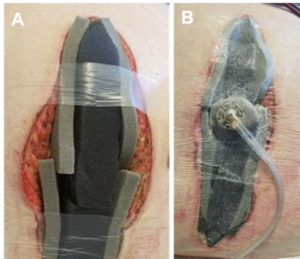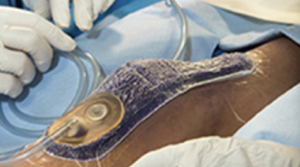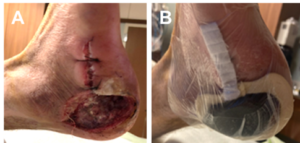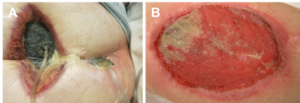
Emily Greenstein, APRN, CNP, CWON, FACCWS is a Certified Nurse Practitioner at Sanford Health in Fargo, ND. She is certified as an Adult-Gerontology Nurse Practitioner through the American Academy of Nurse Practitioners. She has been certified in wound and ostomy care through the WOCNCB for the past 9 years. At Sanford she oversees the outpatient wound care program, serves as chair for the SVAT committee and is involved in many different research projects. Ms. Greenstein is a consultant for KCI.
Greenstein_Current Dialogues in Wound Management_2020_Article_12
Negative pressure wound therapy (NPWT) has become an important treatment modality for a variety of wounds. New NPWT technology has emerged over the last few years with the specific aims of helping to prevent surgical incision complications and including the instillation of topical wound solutions to combine wound cleansing with intermittent negative pressure therapy. The objective of this article is to provide clinicians with tips and techniques to obtain and maintain a negative pressure seal to help ensure continuous therapy and patient compliance.
Brief Overview of NPWT Systems
V.A.C.® Therapy
V.A.C.® Therapy applies continuous negative pressure across the wound bed using reticulated open cell foam dressings, adhesive drape, therapy unit that provides negative pressure, and self-adjusting pressure technology (SENSAT.R.A.C.™ Technology). When negative pressure is present, this therapy draws wound edges together, removes wound exudate and infectious materials. Additionally, NPWT provides a barrier against external contaminants.
V.A.C. VERAFLO™ Therapy.
V.A.C. VERAFLO™ Therapy combines the benefits of negative pressure wound therapy with the addition of controlled delivery of topical wound solutions (such as saline, wound cleansers, and antiseptics) to the wound bed. V.A.C. VERAFLO™ Therapy involves the instillation of topical wound solutions into the sealed wound through an additional tubing system while the negative pressure cycle is paused. The instillation solution is allowed to dwell for a user-selected period of time (e.g. 10 minutes) after which, the therapy unit resumes the negative pressure cycle and fluid is removed. This process can be repeated as often as is required.1
PREVENA™ Incision Management System
PREVENA™ Incision Management system is NPWT that is applied under sterile conditions immediately after the incision is closed. The PREVENA™ System manages and protects surgical incisions by holding the edges of the incision together, decreasing lateral tension, reducing edema, and protecting the site from external contamination.2
Identifying the ideal patient
The first step in achieving optimal dressing application or therapy outcome is to identify the ideal patient for each NPWT system.
Table 1 lists indications and contraindications for use for V.A.C.® Therapy, V.A.C. VERAFLO™ Therapy, and the PREVENA™ System. Refer to the manufacturer’s instructions for use for complete safety information.

Application Tips
General Application Tips
Clean and assess the wound prior to NPWT application and perform a complete assessment of the wound. Look for undermining, tunneling, exposed vessels, or potential contraindications for the use of the therapy (Figure 1). During the wound assessment, note the quality of the periwound skin. If the periwound skin shows signs of compromise such as breakdown, maceration, or fungal infection, consider treating those prior to the application of NPWT.

Once the dressing is applied, turn on the NPWT unit, making sure there are no leaks which could cause loss of negative pressure and reduce the effectiveness of the therapy.
Check the screen to make sure the negative pressure you selected is being achieved (the most common setting is -125 mmHg). Finally, document the dressing changes by noting the wound assessment, the number of pieces of foam placed in the wound, additional materials you used to achieve a seal, the system settings, and how the patient tolerated the procedure.
When applying V.A.C. VERAFLO™ Therapy, the dressing must come into contact with the entire wound bed. For larger wounds that may be suitable for the use of V.A.C. VERAFLO CLEANSE CHOICE™ Dressings, the dressings should be placed in direct contact with the wound bed followed by application of a V.A.C. VERAFLO™ Dressing to fill the wound void (Figure 2).

Application of the PREVENA™ System over clean, closed incisions should ensure that the full length of the incision is covered with the foam dressing (Figure 3). Care should be taken when applying the drape to not over stretch it and create points of skin tension around the dressing or periwound skin once negative pressure is initiated.

Common Application Challenges and Solutions
1. Application of NPWT Around Medical Devices
Medical devices, such as pins, external fixators, or tubes, can make application of NPWT difficult. The use of ostomy seals or strip paste is a good way to help obtain a seal around these devices. If choosing this option, place the ostomy rings as a form of “putty” around the device, under the NPWT drape. You can also use ostomy paste which works as a form of “caulking”. Stoma paste, which has no adhesive properties, will dry and form a barrier around devices and in skin creases.
2. Difficult Wound Locations
Some patients have wounds that are located in difficult anatomical positions. For example, NPWT application can be difficult in patients with Fournier’s Gangrene, a form of necrotizing fasciitis affects the groin and perineal area.3 This wound location has moisture and skin fold challenges. One technique is to make sure that the patient’s skin is extremely dry prior to applying the dressing. This can be achieved by washing the periwound skin with soap and water, patting dry with a towel, and applying a skin protectant spray or wipe. Ostomy rings and seals can also be used to fill in skin creases and folds. It may also be helpful to apply the negative pressure dressings with a colleague so one person can pull the skin taut whilst the other is applying the drape.
3. Wounds Within an Incision
There are patients who need NPWT on a wound that may be in the middle of an incision where only one end of an incision has dehisced. In this scenario, the features of both the incision and the open wound need to be taken into account. One technique is to apply a non-adherent dressing and the NPWT foam dressing over the intact incision. You will need to place a drape in picture frame fashion around the incision line. Another option is to place a protective dressing over the incision line under the drape to prevent maceration or further breakdown of the incision. A hydrofiber dressing placed over the incision line can accomplish this (Figure 4).

4. Periwound Skin Irritation and Maceration
The most common cause of periwound skin irritation occurs with improper application of NPWT system dressings. A foam dressing that is too small can cause pulling and irritation at the wound edges, along with inadequate removal of wound exudate. Similarly, foam dressings that are too large, overlap onto the periwound skin and can cause irritation (Figure 5). Making sure to cut the foam dressings to exactly fit the wound bed can eliminate this issue.

In highly exudating wounds, improper removal of exudate and/or negative pressure seal loss can lead to periwound skin maceration. Application of a skin protectant before applying the drape can help alleviate this problem.
5. Pain
NPWT dressing changes can be painful for patients. Some may need oral or intravenous analgesics administered prior to the dressing change. During removal of V.A.C. VERAFLO™ Dressings, it can be helpful to pre-wet the dressing with the instillation solution prior to removal. Other suggestions include hair removal for periwound skin, skin protection prior to drape application, using no-sting barrier wipes to remove the drape, and drape removal in a horizontal direction.
6. Skin Fragility
To protect fragile periwound skin you can use a hydrocolloid barrier. More recently, a novel hybrid drape consisting of a polyurethane film with acrylic adhesive and a silicone perforated layer (V.A.C. DERMATAC™ Drape) has been developed for use with V.A.C.® Therapy. The drape can be repositioned during the initial dressing application and is easier to remove during dressing changes. Preliminary small case studies have reported the ability of the drape to be repositioned and reduced patient pain with the drape removal.4-8 Another approach is to use skin preparation products prior to applying any type of adhesive to the patient’s skin.
By following some of these tips for the application of NPWT system dressings, you can help minimize patient discomfort and improve patient compliance to help heal the patient’s wounds.
Photos courtesy of Emily Greenstein, NP.
NOTE: Specific indications, contraindications, warnings, precautions, and safety information exist for these products and therapies. Please consult a clinician and product instructions for use prior to application. Rx only.
References
- Wolvos T. Wound instillation – The next step in negative pressure wound therapy. Lessons learned from initial experiences. Ostomy Wound Manage 2004;50(11):56-66.
- Lee K, Murphy PB, Ingves MV et al. Randomized clinical trial of negative pressure wound therapy for high-risk groin wounds in lower extremity revascularization. J Vasc Surg 2017;66(6):1814-1819.
- Chernyadyev SA, Ufimtseva MA, Vishnevskaya IF et al. Fournier’s Gangrene: Literature Review and Clinical Cases. Urol Int 2018;101(1):91-97. doi:10.1159/000490108.
- Desvigne MN, Berman ML, Aragon J et al. Initial Experiences Applying Negative Pressure Wound Therapy With a Novel Drape Containing an Acrylic and Silicone-based Adhesive [abstract]. Presented at SAWC Fall 2019, October 12-16, 2019, Las Vegas, NV 2019.
- Gabriel A, Pfaffenberger M, Eldenburg E, Mayer D, Nelson J, Gold R. Use of a Novel Silicone-Acrylic Drape With Negative Pressure Wound Therapy to Bolster Skin Grafts and Flaps. Presented at SAWC Fall 2019, October 12-14, 2019, Las Vegas, NV 2019.
- Galarza L. Initial clinical observations using a novel negative pressure wound therapy drape comprised of acrylic and silicone. Presented at SAWC Spring 2019, May 7-11, 2019, San Antonio, TX 2019.
- Napolitano RJ, Jr. Early use of a novel acrylic-silicone hybrid drape with negative pressure wound therapy in lower extremity wounds [abstract]. Presented at SAWC Fall 2019, October 12-14, 2019, Las Vegas, NV 2019.
- Speyrer MS, Thibodeaux KT. Initial experience of negative pressure wound therapy using a novel hybrid adhesive drape [abstract]. Presented at the 2019 Wild on Wounds National Wound Conference, September 11-14, 2019, Las Vegas, NV 2019.
©Copyright 2020 3M. All rights reserved. 3M and the other marks shown are marks and/or registered marks. Unauthorized use prohibited. PRA-PM-US-02514 (06/20).

